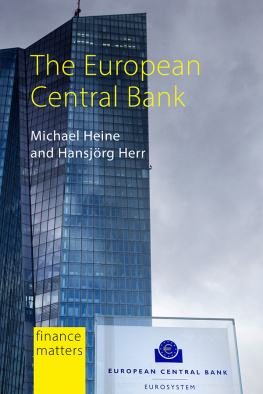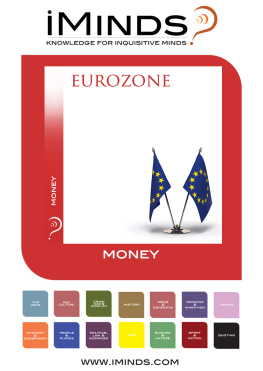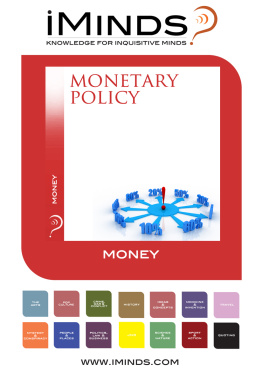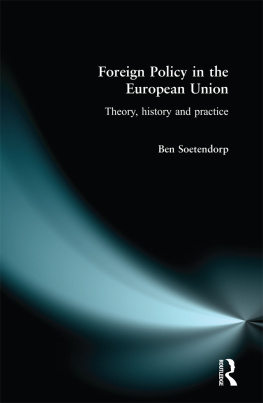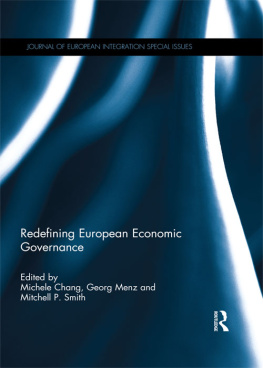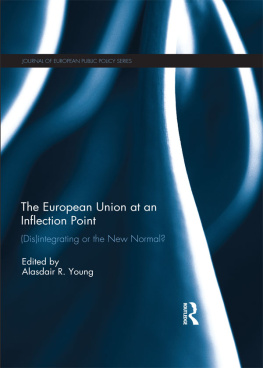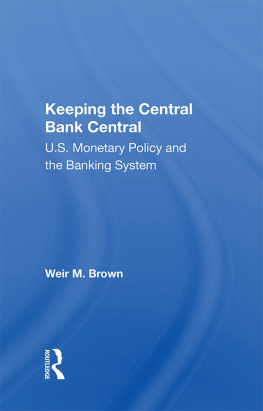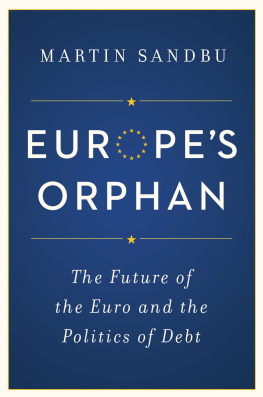THE EUROPEAN CENTRAL BANK
Finance Matters
Series Editors: Kathryn Lavelle, Case Western Reserve University, Cleveland, Ohio and Timothy J. Sinclair, University of Warwick
This series of books provides advanced introductions to the processes, relationships and institutions that make up the global financial system. Suitable for upper-level undergraduate and taught graduate courses in financial economics and the political economy of finance and banking, the series explores all aspects of the workings of the financial markets within the context of the broader global economy.
Published
Banking on the State: The Political Economy of Public Savings Banks
Mark K. Cassell
The European Central Bank
Michael Heine and Hansjrg Herr
Quantitative Easing: The Great Central Bank Experiment
Jonathan Ashworth
THE EUROPEAN CENTRAL BANK
MICHAEL HEINE AND HANSJRG HERR

Michael Heine and Hansjrg Herr 2021
This book is copyright under the Berne Convention.
No reproduction without permission.
All rights reserved.
First published in 2021 by Agenda Publishing
Agenda Publishing Limited
The Core
Bath Lane
Newcastle Helix
Newcastle upon Tyne
NE4 5TF
www.agendapub.com
ISBN 978-1-78821-294-6 (hardcover)
ISBN 978-1-78821-295-3 (paperback)
British Library Cataloguing-in-Publication Data
A catalogue record for this book is available from the British Library
Typeset by Newgen Publishing UK
Printed and bound in the UK by CPI Group (UK) Ltd, Croydon, CR0 4YY
CONTENTS
TABLES AND FIGURES
TABLES
FIGURES
PREFACE
With the creation of the European Monetary Union (EMU) in 1999, the participating member states took a bold step towards further economic and political integration. The development followed the logic of European integration since the Second World War start with economic integration and political integration will follow. However, the creation of a monetary union implies that member states are giving up national sovereignty and establishing supranational institutions. At the very least a supranational central bank is needed to manage the EMUs monetary policy.
The preparation for the implementation of monetary union was far from complete. The European Central Bank (ECB) was created but other powerful supranational institutions in the EMU were missing. A vacuum developed with insufficient institutions in the EMU to manage its macroeconomic development while reducing room for manoeuvre for macroeconomic policy at the national level. The history of EMU is a history of the ECB struggling with the incompleteness of the monetary union. Cooperation among states could have reduced the lack of institutions in the EMU. However, cooperation was insufficient and became interwoven with the struggle of different member countries to increase or defend their influence and enforce their own economic policy strategy. Germany as the biggest country in the EMU followed hegemonic ambitions. However, its power and willingness to stabilize the whole monetary union was incomplete.
With this in mind, we analyse the history of the EMU and especially the policy and role of the ECB in the framework of macroeconomic management. The first draft of the book was finished in early 2020, just as the Covid-19 crisis hit Europe. We then added to provide some analysis of the early response to the crisis as far as this is possible in June 2020.
We would like to thank Alison Howson for support and debates and for her encouragement to write this book. We also thank an anonymous reviewer for helpful comments. Last but not least, we thank Lukas Handley for his technical support.
Michael Heine
Hansjrg Herr
INTRODUCTION: EUROPEAN INTEGRATION
The idea of creating a borderless Europe, while preserving the cultural independence of the individual countries or regions, is centuries old. In recent history, the first moves towards political European integration date back to the early twentieth century, but the First World War put paid to any ideas of integration and left Europe divided. It was not until after the Second World War that the first serious attempt at European integration took place. The United States, in particular, strongly encouraged and supported economic and political integration in Europe, as a strong Europe provided a buffer to Soviet ambitions during the Cold War. The American European Recovery Program, also known as the Marshall Plan, made a considerable financial and political contribution to integration in the western part of Europe and included cooperation between the formerly hostile countries.
A formal alliance between the main continental European countries became concrete in 1951 (in force 1952) with the foundation of the European Coal and Steel Community, signatories to which were Belgium, the Federal Republic of Germany, France, Italy, Luxembourg and the Netherlands. These six countries also founded the European Atomic Energy Community, including Euratom, as a joint international organization in 1957 (in force since 1958).
In 1957 (in force 1958) the Treaty of Rome, the treaty establishing the European Economic Community (EEC) was agreed. The main focus of this agreement was on the stepwise reduction of customs duties between the member states and the common organization of agriculture. The customs union decided in the Treaty of Rome came into force in 1968. A further step towards integration took place in 1967 when the three previous agreements were merged to form the European Community (EC). These integration steps were accompanied by the expansion of the Community with the accession of new member states.
At the monetary level, in the 1950s and 1960s, European integration took place under the umbrella of the Bretton Woods system signed in 1944 and established in 1946. The system implemented fixed exchange rates, which could ).
After the Treaty of Rome, with the exception of the EMS, there were no further attempts to deepen integration for a long time. The EC was completely preoccupied with the enlargement process and there was no political mobilization for further integration. This changed in the mid-1980s. In 1986 (in force 1987) the European Single Act was passed. The aim of which was to create a common internal market by the end of 1992. Until then, the customs union formed the core of European integration, which excluded many sectors including the insurance and banking industry and transport to public tenders. The four (indivisible) freedoms to be implemented in the European Single Act were:
Free movement of persons (e.g. abolition of border controls, freedom of establishment of firms and employment);
Free movement of all services (e.g. liberalization of financial services and transport and communications sectors);
Free movement of all goods (e.g. elimination of customs duties and non-tariff restrictions);
Free movement of capital (e.g. liberalization of financial markets, elimination of existing capital controls).
By the end of 1992, all of the goals set out in the Act had been achieved.
Jacques Delors, president of the European Commission from 1985 to 1995, was the main driving force behind monetary integration. In 1988, the heads of governments of the member states of the EC instructed Delors to chair a committee to draw up proposals for monetary integration.: 650f.).
Britain was not prepared to give up the freedom to follow its own economic policy. For Germany which dominated the EMS the present EMS is in some respects so attractive from a German viewpoint that it may be difficult to persuade Germany to reform the system (Thygesen : 647). The establishment of an independent central bank, the clear objective of price stability in a monetary union and the proposal in the Delors Report for budgetary rules made the project more appealing for the Germans. France actively supported the plan for a monetary union in the Delors Report. It was obviously convinced that it would be able to compete successfully with Germany in a monetary union, having already lost much of its monetary policy autonomy to Germany in the EMS anyway. Italy and smaller EMS countries followed the French line.

